Monitoring Gypsiferous Soils by Leveraging Advanced Spaceborne Hyperspectral Imagery via Spectral Indices and a Machine Learning Approach
Abstract
1. Introduction
2. Materials and Methods
2.1. Study Area
Soil Sampling
2.2. Methodology
2.3. Data Gathering
2.3.1. Laboratory Analyses
2.3.2. Laboratory VNIR-SWIR Spectroscopy and Preprocessing
2.3.3. Remote Sensing Data
Hyperspectral Satellite Data Preprocessing
Bare-Soil Pixel Selection
2.4. Parametric and Non-Parametric Regression
2.4.1. Narrowband Spectral Indices
2.4.2. Gypsum Absorption Feature Parametrization
2.4.3. Learning Algorithms
2.5. Model Training and Validation
3. Results
3.1. General Statistics
3.2. EnMAP/PRISMA Spectral Quality for Gypsum Study
3.3. Gypsum Retrieval Using Narrowband Spectral Indices
3.4. Soil Gypsum Content Retrieval Using HAP and SLP Indices
3.5. Gypsum Retrieval Using ML Algorithms
4. Discussion
4.1. Evaluating Spectral Index Performance for Gypsum Content Retrieval
4.2. Evaluation of ML Methods for Accurate Gypsum Retrieval from Hyperspectral Data
4.3. Assessing PRISMA and EnMAP Capabilities in Gypsum Retrieval
4.4. Comparative Evaluation of Gypsum Spatial Mapping Using PRISMA and EnMAP
4.5. Limitations and Future Work
5. Conclusions
Author Contributions
Funding
Data Availability Statement
Conflicts of Interest
References
- Styc, Q.; Pachon, J.; Padarian, W.; McBratney, A. Creating soil districts for Australia based on pedogenon mapping. Geoderma 2025, 454, 117164. [Google Scholar] [CrossRef]
- GLASOD. Global Assessment of Human-Induced Soil Degradation. 1991. Available online: https://isric.org/projects/global-assessment-human-induced-soil-degradation-glasod (accessed on 1 June 2024).
- Becker Pickson, R.; Gui, P.; Chen, A.; Boateng, E. Climate change and food security nexus in Asia: A regional comparison. Ecol. Inform. 2023, 76, 102038. [Google Scholar] [CrossRef]
- Wang, J.; Wang, Y.; Xu, D. Desertification in northern China from 2000 to 2020: The spatial-temporal processes and driving mechanisms. Ecol. Inform. 2024, 82, 102769. [Google Scholar] [CrossRef]
- Eisele, A.; Chabrillat, S.; Hecker, C.; Hewson, R.; Lau, I.C.; Rogass, C.; Segl, K.; Cudahy, T.J.; Udelhoven, T.; Hostert, P.; et al. Advantages using the thermal infrared (TIR) to detect and quantify semi-arid soil properties. Remote Sens. Environ. 2015, 163, 296–311. [Google Scholar] [CrossRef]
- Chakherlou, S.; Jafarzadeh, A.A.; Ahmadi, A.; Feizizadeh, B.; Shahbazi, F.; Darvishi Boloorani, A.; Mirzaei, S. Soil wind erodibility and erosion estimation using Landsat satellite imagery and multiple-criteria decision analysis in Urmia Lake Region, Iran. Arid Land Res. Manag. 2022, 37, 71–91. [Google Scholar] [CrossRef]
- Soil Resources, Management and Conservation Service; FAO. Management of Gypsiferous Soils; FAO Soils Bulletin 62; FAO: Rome, Italy, 1990. [Google Scholar]
- Milewski, R.; Chabrillat, S.; Brell, M.; Schleicher, A.; Guanter, L. Assessment of the 1.75 μm absorption feature for gypsum estimation using laboratory, air- and spaceborne hyperspectral sensors. Int. J. Appl. Earth Obs. Geoinf. 2019, 77, 69–83. [Google Scholar] [CrossRef]
- Rasooli, N.; Farpoor, M.H.; Mahmoodabadi, M.; Esfandiarpour Boroujeni, I. Genesis and distribution of different mineral assemblages controlled by environmental factors in soils and evaporitic deposits of Lut Desert, central Iran. Environ. Earth Sci. 2021, 80, 779. [Google Scholar] [CrossRef]
- Marques, M.J.; Alvarez, A.M.; Carral, P.; Esparza, I.; Sastre, B.; Bienes, R. Estimating soil organic carbon in agricultural gypsiferous soils by diffuse reflectance spectroscopy. Water 2020, 12, 261. [Google Scholar] [CrossRef]
- Casby-Horton, S.; Herrero, J.; Rolong, N.A. Chapter Four—Gypsum Soils—Their Morphology, Classification, Function, and Landscapes. Adv. Agron. 2015, 130, 23–81. [Google Scholar]
- Verheye, W.H.; Boyadgiev, T.G. Evaluating the land use potential of gypsiferous soils from field pedogenic characteristics. Soil Use Manag. 1997, 13, 97–103. [Google Scholar] [CrossRef]
- Smith, R.; Robertson, V.C. Soil and irrigation classification of shallow soils overlying gypsum beds, northern Iraq. J. Soil Sci. 1962, 13, 106–115. [Google Scholar] [CrossRef]
- Herrero, J.; Artieda, O.; Hudnall, W.H. Gypsum, a Tricky Material. Soil Sci. Soc. Am. J. 2009, 73, 1757–1763. [Google Scholar] [CrossRef]
- Poch, R.M.; De Coster, W.; Stoops, G. Pore space characteristics as indicators of soil behaviour in gypsiferous soils. Geoderma 1998, 87, 87–109. [Google Scholar] [CrossRef]
- Etesami, H.; Halajian, L.; Jamei, M. A qualitative land suitability assessment in gypsiferous soils of Kerman Province, Iran. Aust. J. Basic Appl. Sci. 2012, 6, 60–64. [Google Scholar]
- Moret-Fernandez, D.; Herrero, J. Effect of gypsum content on soil water retention. J. Hydrol. 2015, 528, 122–126. [Google Scholar] [CrossRef]
- Porta, J. Methodologies for the analysis and characterization of gypsum in soils: A review. Geoderma 1998, 87, 31–46. [Google Scholar] [CrossRef]
- Viscarra Rossel, R.A.; Shen, Z.; Lopez, L.R.; Behrens, T.; Shi, Z.; Wetterlind, J.; Sudduth, K.A.; Stenberg, B.; Guerrero, C.; Gholizadeh, A.; et al. An imperative for soil spectroscopic modelling is to think global but fit local with transfer learning. Earth Sci. Rev. 2024, 254, 104479. [Google Scholar] [CrossRef]
- Demattê, J.A.; Rizzo, R.; Rosin, N.A.; Poppiel, R.R.; Novais, J.J.M.; Amorim, M.T.A.; Rodriguez-Albarracín, H.S.; Rosas, J.T.F.; dos Anjos Bartsch, B.; Vogel, L.G.; et al. A global soil spectral grid based on space sensing. Sci. Total Environ. 2025, 968, 178791. [Google Scholar] [CrossRef] [PubMed]
- Novais, J.J.M.; Melo, B.M.D.; Junior, A.F.N.; Lima, R.H.C.; Souza, R.E.; Melo, V.F.; Amaral, E.F.; Tziolas, N.; Demattê, J.A.M. Online analysis of Amazon’s soils through reflectance spectroscopy and cloud computing can support policies and sustainable development. J. Environ. Manag. 2025, 375, 124155. [Google Scholar] [CrossRef]
- Wang, S.; Guan, K.; Zhang, C.; Jiang, C.; Zhou, Q.; Li, K.; Herzberger, L. Airborne hyperspectral imaging of cover crops through radiative transfer process-guided machine learning. Remote Sens. Environ. 2023, 285, 113386. [Google Scholar] [CrossRef]
- Chabrillat, S.; Ben-Dor, E.; Cierniewski, J.; Gomez, C.; Schmid, T.; van Wesemael, B. Imaging spectroscopy for soil mapping and monitoring. Surv. Geophys. 2019, 40, 361–399. [Google Scholar] [CrossRef]
- Khosravi, V.; Gholizadeh, A.; Žížala, D.; Kodešová, R.; Saberioon, M.; Agyeman, P.C.; Vokurková, P.; Juřicová, A.; Spasić, M.; Borůvka, L. On the impact of soil texture on local scale organic carbon quantification: From airborne to spaceborne sensing domains. Soil Tillage Res. 2024, 241, 106125. [Google Scholar] [CrossRef]
- Stenberg, B.; Viscarra-Rossel, R.A. Diffuse reflectance spectroscopy for high-resolution soil sensing. In Proximal Soil Sensing; Springer: Dordrecht, The Netherlands, 2010; pp. 29–47. [Google Scholar]
- Hunt, G.R.; Salisbury, J.W. Visible and near-infrared spectra of minerals and rocks. II. Carbonates. Mod. Geol. 1971, 2, 23–30. [Google Scholar]
- Cloutis, E.A.; Hawthorne, F.C.; Mertzman, S.A.; Krenn, K.; Craig, M.A.; Marciano, D.; Methot, M.; Strong, J.; Mustard, J.F.; Blaney, D.L.; et al. Detection and discrimination of sulfate minerals using reflectance spectroscopy. Icarus 2006, 184, 121–157. [Google Scholar] [CrossRef]
- Bishop, J.L.; Lane, M.D.; Dyar, M.D.; King, S.J.; Brown, A.J.; Swayze, G.A. Spectral properties of Ca-sulfates: Gypsum, bassanite, and anhydrite. Am. Mineral. 2014, 99, 2105–2115. [Google Scholar] [CrossRef]
- Liu, Y.; Wang, A.; Freeman, J.J. Raman, MIR and NIR spectroscopic study of calcium sulfates: Gypsum, bassanite and anhydrite. In Proceedings of the 40th Lunar and Planetary Science Conference, Houston, TX, USA, 23–27 March 2009; p. 2128. [Google Scholar]
- Rasooli, N.; Farpoor, M.H.; Mahmoodabadi, M.; Esfandiarpour Boroujeni, I. Vis-NIR spectroscopy as an eco-friendly method for monitoring pedoenvironmental variations and pedological assessments in Lut Watershed, Central Iran. Soil Tillage Res. 2023, 233, 105808. [Google Scholar] [CrossRef]
- Gholizadeh, A.; Žižala, D.; Saberioon, M.; Borůvka, L. Soil organic carbon and texture retrieving and mapping using proximal, airborne, and Sentinel-2 spectral imaging. Remote Sens. Environ. 2018, 218, 89–103. [Google Scholar] [CrossRef]
- Angelopoulou, T.; Tziolas, N.; Balafoutis, A.; Zalidis, G.; Bochtis, D. Remote sensing techniques for soil organic carbon estimation: A review. Remote Sens. 2019, 11, 676. [Google Scholar] [CrossRef]
- Castaldi, F. Sentinel-2 and Landsat-8 multi-temporal series to estimate topsoil properties on croplands. Remote Sens. 2021, 13, 3345. [Google Scholar] [CrossRef]
- Van Wesemael, B.; Abdelbaki, A.; Ben-Dor, E.; Chabrillat, S.; d’Angelo, P.; Demattê, J.A.; Genova, G.; Gholizadeh, A.; Heiden, U.; Karlshoefer, P.; et al. A European soil organic carbon monitoring system leveraging Sentinel 2 imagery and the LUCAS soil database. Geoderma 2024, 452, 117113. [Google Scholar] [CrossRef]
- Kovárník, R.; Janová, J. Validation of Sentinel-2-based machine learning models for Czech National Forest Inventory. Ecol. Inform. 2025, 87, 103133. [Google Scholar] [CrossRef]
- Asadzadeh, S.; Koellner, N.; Chabrillat, S. Detecting rare earth elements using EnMAP hyperspectral satellite data: A case study from Mountain Pass, California. Sci. Rep. 2024, 14, 20766. [Google Scholar] [CrossRef] [PubMed]
- Castaldi, F.; Palombo, A.; Santini, F.; Pascucci, S.; Pignatti, S.; Casa, R. Evaluation of the potential of the current and forthcoming multispectral and hyperspectral imagers to estimate soil texture and organic carbon. Remote Sens. Environ. 2016, 179, 54–65. [Google Scholar] [CrossRef]
- Gomez, C.; Adeline, K.; Bacha, S.; Driessen, B.; Gorretta, N.; Lagacherie, P.; Roger, J.M.; Briottet, X. Sensitivity of clay content prediction to spectral configuration of VNIR/SWIR imaging data, from multispectral to hyperspectral scenarios. Remote Sens. Environ. 2018, 204, 18–30. [Google Scholar] [CrossRef]
- Mzid, N.; Castaldi, F.; Tolomio, M.; Pascucci, S.; Casa, R.; Pignatti, S. Evaluation of agricultural bare soil properties retrieval from Landsat 8, Sentinel-2, and PRISMA satellite data. Remote Sens. 2022, 14, 714. [Google Scholar] [CrossRef]
- Gleeson, D.F.; Pappalardo, R.T.; Grasby, S.E.; Anderson, M.S.; Beauchamp, B.; Castaño, R.; Chien, S.A.; Doggett, T.; Mandrake, L.; Wagstaff, K.L. Characterization of a sulfur-rich Arctic spring site and field analog to Europa using hyperspectral data. Remote Sens. Environ. 2010, 114, 1297–1311. [Google Scholar] [CrossRef]
- Ben-Dor, E.; Chabrillat, S.; Demattê, J.A.M.; Taylor, G.R.; Hill, J.; Whiting, M.L.; Sommer, S. Using imaging spectroscopy to study soil properties. Remote Sens. Environ. 2009, 113, S38–S55. [Google Scholar] [CrossRef]
- Wocher, M.; Berger, K.; Verrelst, J.; Hank, T. Retrieval of carbon content and biomass from hyperspectral imagery over cultivated areas. ISPRS J. Photogramm. Remote Sens. 2022, 193, 104–114. [Google Scholar] [CrossRef]
- Ward, K.; Foerster, S.; Chabrillat, S. Estimating soil organic carbon using multitemporal PRISMA imaging spectroscopy data. Geoderma 2024, 450, 117025. [Google Scholar] [CrossRef]
- Angelopoulou, T.; Chabrillat, S.; Pignatti, S.; Milewski, R.; Karyotis, K.; Brell, M.; Ruhtz, T.; Bochtis, D.; Zalidis, G. Evaluation of airborne HySpex and spaceborne PRISMA hyperspectral remote sensing data for soil organic matter and carbonates estimation. Remote Sens. 2023, 15, 1106. [Google Scholar] [CrossRef]
- Mirzaei, S.; Casa, R.; Guarini, R.; Laneve, G.; Marrone, L.; Misbah, K.; Pascucci, S.; Pignatti, S.; Rossi, F.; Tricomi, A. Reduction of the vegetation and soil moisture effects to improve topsoil properties retrieval accuracy from PRISMA images. In Proceedings of the IEEE International Geoscience and Remote Sensing Symposium IGARSS, Athens, Greece, 7–12 July 2024; pp. 2243–2246. [Google Scholar]
- Rossi, F.; Casa, R.; Huang, W.; Laneve, G.; Linyi, L.; Mirzaei, S.; Pascucci, S.; Pignatti, S.; Yu, R. Predicting soil nutrients with PRISMA hyperspectral data at the field scale: The Handan (south of Hebei Province) test cases. Geo-Spat. Inf. Sci. 2024, 27, 870–891. [Google Scholar] [CrossRef]
- Rasooli, N.; Mirzaei, S.; Pignatti, S. Electrical Conductivity and calcium carbonate mapping combining PRISMA imagery and machine learning techniques. In Proceedings of the IEEE International Geoscience and Remote Sensing Symposium IGARSS, Athens, Greece, 7–12 July 2024; pp. 3678–3681. [Google Scholar]
- Asadzadeh, S.; Zhou, X. Assessment of the spaceborne EnMAP hyperspectral data for alteration mineral mapping: A case study of the Reko Diq porphyry Cu–Au deposit, Pakistan. Remote Sens. Environ. 2024, 314, 114389. [Google Scholar] [CrossRef]
- Nawar, S.; Buddenbaum, H.; Hill, J. Estimation of soil salinity using three quantitative methods based on visible and near-infrared reflectance spectroscopy: A case study from Egypt. Arab. J. Geosci. 2015, 8, 5127–5140. [Google Scholar] [CrossRef]
- Khan, A.; Vibhute, A.D.; Mali, S.H.; Patil, C.H. A systematic review on hyperspectral imaging technology with a machine and deep learning methodology for agricultural applications. Ecol. Inform. 2022, 69, 101678. [Google Scholar] [CrossRef]
- Peon, J.; Recondo, C.; Fernandez, S.; Calleja, J.F.; De Miguel, E.; Laura, C. Prediction of topsoil organic carbon using airborne and satellite hyperspectral imagery. Remote Sens. 2017, 9, 1211. [Google Scholar] [CrossRef]
- Verrelst, J.; Malenovský, Z.; Van der Tol, C.; Camps-Valls, G.; Gastellu-Etchegorry, J.P.; Lewis, P.; North, P.; Moreno, J. Quantifying vegetation biophysical variables from imaging spectroscopy data: A review on retrieval methods. Surv. Geophys. 2019, 40, 589–629. [Google Scholar] [CrossRef]
- Ward, K.J.; Chabrillat, S.; Brell, M.; Castaldi, F.; Spengler, D.; Foerster, S. Mapping soil organic carbon for airborne and simulated EnMAP imagery using the LUCAS soil database and a local PLSR. Remote Sens. 2020, 12, 3451. [Google Scholar] [CrossRef]
- Tsakiridis, N.L.; Keramaris, K.D.; Theocharis, J.B.; Zalidis, G.C. Simultaneous prediction of soil properties from VNIR-SWIR spectra using a localized multi-channel 1-D convolutional neural network. Geoderma 2020, 367, 114208. [Google Scholar] [CrossRef]
- Shen, Z.; Viscarra Rossel, R.A. Automated spectroscopic modelling with optimized convolutional neural networks. Sci. Rep. 2021, 11, 1–12. [Google Scholar]
- Behrens, T.; Viscarra Rossel, R.A.; Ramirez-Lopez, L.; Baumann, P. Soil spectroscopy with the Gaussian pyramid scale space. Geoderma 2022, 426, 116095. [Google Scholar] [CrossRef]
- Hengl, T.; Nikolić, M.; MacMillan, R.A. Mapping efficiency and information content. Int. J. Appl. Earth Obs. Geoinf. 2013, 22, 127–138. [Google Scholar] [CrossRef]
- Krinsley, D.B. A Geomorphological and Paleoclimatological Study of the Playas of Iran. Ph.D. Thesis, Geological Survey, U.S. Department of Interior, Washington, DC, USA, 1970; p. 486. [Google Scholar]
- Dultz, S.; Kuhn, P. Occurrence, formation, and micromorphology of gypsum in soils from the Central German Chernozem region. Geoderma 2005, 129, 230–250. [Google Scholar] [CrossRef]
- Soil Survey Staff. Keys to Soil Taxonomy, 13th ed.; USDA Natural Resources Conservation Service: Washington, DC, USA, 2022. [Google Scholar]
- Pignatti, S.; Amodeo, A.; Carfora, M.F.; Casa, R.; Mona, L.; Palombo, A.; Pascucci, S.; Rosoldi, M.; Santini, F.; Laneve, G. PRISMA L1 and L2 Performances within the PRISCAV Project: The Pignola Test Site in Southern Italy. Remote Sens. 2022, 14, 1985. [Google Scholar] [CrossRef]
- Chabrillat, S.; Foerster, S.; Segl, K.; Beamish, A.; Brell, M.; Asadzadeh, S.; Milewski, R.; Ward, K.J.; Brosinsky, A.; Koch, K.; et al. The EnMAP spaceborne imaging spectroscopy mission: Initial scientific results two years after launch. Remote Sens. Environ. 2024, 315, 114379. [Google Scholar] [CrossRef]
- Cogliati, S.; Sarti, F.; Chiarantini, L.; Cosi, M.; Lorusso, R.; Lopinto, E.; Miglietta, F.; Genesio, L.; Guanter, L.; Damm, A.; et al. The PRISMA imaging spectroscopy mission: Overview and first performance analysis. Remote Sens. Environ. 2021, 262, 112499. [Google Scholar] [CrossRef]
- Storch, T.; Honold, H.P.; Chabrillat, S.; Habermeyer, M.; Tucker, P.; Brell, M.; Ohndorf, A.; Wirth, K.; Betz, M.; Kuchler, M.; et al. The EnMAP imaging spectroscopy mission towards operations. Remote Sens. Environ. 2023, 294, 113632. [Google Scholar] [CrossRef]
- Daughtry, C.S. Discriminating crop residues from soil by shortwave infrared reflectance. Agron. J. 2001, 93, 125–131. [Google Scholar] [CrossRef]
- Rouse, J.W.; Haas, R.H.; Schell, J.A.; Deering, D.W. Monitoring vegetation systems in the Great Plains with ERTS. NASA Spec. Publ. 1974, 351, 309. [Google Scholar]
- Nagler, P.L.; Inoue, Y.; Glenn, E.P.; Russ, A.L.; Daughtry, C.S.T. Cellulose absorption index (CAI) to quantify mixes of soil-plant litter scenes. Remote Sens. Environ. 2003, 87, 310–325. [Google Scholar] [CrossRef]
- Burden, R.; Faires, L.; Douglas, J. Numerical Analysis, 9th ed.; Brooks/Cole, Cengage Learning: Boston, MA, USA, 2011. [Google Scholar]
- Liu, B.; Guo, B.; Zhuo, R.; Dai, F. Estimation of soil organic carbon in LUCAS soil database using Vis-NIR spectroscopy based on hybrid kernel Gaussian process regression. Spectrochim. Acta Part A Mol. Biomol. Spectrosc. 2024, 321, 124687. [Google Scholar] [CrossRef]
- Zeraatpisheh, M.; Garosi, Y.; Reza Owliaie, H.; Ayoubi, S.; Taghizadeh-Mehrjardi, R.; Scholten, T.; Xu, M. Improving the spatial prediction of soil organic carbon using environmental covariates selection: A comparison of a group of environmental covariates. Catena 2022, 208, 105723. [Google Scholar] [CrossRef]
- Abdel-Rahman, E.M.; Mutanga, O.; Odindi, J.; Adam, E.; Odindo, A.; Ismail, R. Estimating Swiss chard foliar macro- and micronutrient concentrations under different irrigation water sources using ground-based hyperspectral data and four partial least squares (PLS)-based (PLS1, PLS2, SPLS1, and SPLS2) regression algorithms. Comput. Electron. Agric. 2017, 132, 21–33. [Google Scholar] [CrossRef]
- Breiman, L. Random forests. Mach. Learn. 2001, 45, 5–32. [Google Scholar] [CrossRef]
- Basak, D.; Pal, S.; Patranabis, D.C. Support vector regression. Neural Inf. Process. Lett. Rev. 2007, 11, 203–224. [Google Scholar]
- Smola, A.J.; Scholkopf, B. A tutorial on support vector regression. Stat. Comput. 2004, 14, 199–222. [Google Scholar] [CrossRef]
- Zhao, S.; Ayoubi, S.; Mousavi, S.R.; Mireei, S.A.; Shahpouri, F.; Wu, S.X.; Chen, C.B.; Zhao, Z.Y.; Tian, C.Y. Integrating proximal soil sensing data and environmental variables to enhance the prediction accuracy for soil salinity and sodicity in a region of Xinjiang Province, China. J. Environ. Manag. 2024, 364, 121311. [Google Scholar] [CrossRef] [PubMed]
- Wang, B.; Xu, A. Gaussian process methods for nonparametric functional regression with mixed predictors. Comput. Stat. Data Anal. 2019, 131, 80–90. [Google Scholar] [CrossRef]
- Terra, F.D.S. Espectroscopia de Reflectancia do Visível ao Infravermelho m’edio Aplicada aos Estudos Qualitativos e Quantitativos de Solos. Ph.D. Dissertation, Universidade de Sao Paulo, São Paulo, Brazil, 2012. [Google Scholar]
- Nawar, S.; Mouazen, A.M. Predictive performance of mobile vis-near infrared spectroscopy for key soil properties at different geographical scales by using spiking and data mining techniques. Catena 2017, 151, 118–129. [Google Scholar] [CrossRef]
- Viscarra Rossel, R.A.; McGlynn, R.N.; McBratney, A.B. Determining the composition of mineral-organic mixes using UV–Vis–NIR diffuse reflectance spectroscopy. Geoderma 2006, 137, 70–82. [Google Scholar] [CrossRef]
- Wilding, L. Spatial variability: Its documentation, accommodation, and implication to soil surveys. In Soil Spatial Variability: Proceedings of a Workshop of the ISSS and the SSSA; Nielsen, D.R., Bouma, J.J., Eds.; Pudoc: Wageningen, The Netherlands, 1985; pp. 166–194. [Google Scholar]
- Hong, Y.; Chen, S.; Chen, Y.; Linderman, M.; Mouazen, A.M.; Liu, Y.; Guo, L.; Yu, L.; Liu, Y.; Cheng, H.; et al. Comparing laboratory and airborne hyperspectral data for the estimation and mapping of topsoil organic carbon: Feature selection coupled with Random Forest. Soil. Tillage Res. 2020, 199, 104589. [Google Scholar] [CrossRef]
- Nouri, M.; Gomez, C.; Gorretta, N.; Roger, J.M. Clay content mapping from airborne hyperspectral Vis-NIR data by transferring a laboratory regression model. Geoderma 2017, 298, 54–66. [Google Scholar] [CrossRef]
- Dutkiewicz, A.; Lewis, M.; Ostendorf, B. Evaluation and comparison of hyperspectral imagery for mapping surface symptoms of dryland salinity. Int. J. Remote Sens. 2009, 30, 693–719. [Google Scholar] [CrossRef]
- Clark, R.N. Spectroscopy of rocks and minerals, and principles of spectroscopy. Man. Remote Sens. 1999, 3, 2. [Google Scholar]
- Rollin, E.M.; Milton, E.J. Processing of high spectral resolution reflectance data for the retrieval of canopy water content information. Remote Sens. Environ. 1998, 65, 86–92. [Google Scholar] [CrossRef]
- Murphy, R.J. Evaluating simple proxy measures for estimating depth of the ~1900 nm water absorption feature from hyperspectral data acquired under natural illumination. Remote Sens. Environ. 2015, 166, 22–33. [Google Scholar] [CrossRef]
- Stenberg, B.; Koganti, T.; Castaldi, F.; Metzger, K.; Buttafuoco, G.; van Egmond, F.; Cayuela, J.A.; Borůvka, L.; Debaene, G.; Liebisch, F.; et al. D5.1 ProbeField: Best Practice Protocol for Field Spectroscopy and Assessment by Soil Spectral Library Based Calibrations; Version 1; CERN: Genève, Switzerland, 2024. [Google Scholar] [CrossRef]
- Yang, Y.; Shang, K.; Xiao, C.; Wang, C.; Tang, H. Spectral index for mapping topsoil organic matter content based on ZY1-02D satellite hyperspectral data in Jiangsu Province, China. ISPRS Int. J. Geo-Inf. 2022, 11, 111. [Google Scholar] [CrossRef]
- Jin, X.; Du, J.; Liu, H.; Wang, Z.; Song, K. Remote estimation of soil organic matter content in the Sanjiang Plain, Northeast China: The optimal band algorithm versus the GRA-ANN model. Agric. For. Meteorol. 2016, 218, 250–260. [Google Scholar] [CrossRef]
- Chang, N.; Jing, X.; Zeng, W.; Zhang, Y.; Li, Z.; Chen, D.; Jiang, D.; Zhong, X.; Dong, G.; Liu, Q. Soil organic carbon prediction based on different combinations of hyperspectral feature selection and regression algorithms. Agronomy 2023, 13, 1806. [Google Scholar] [CrossRef]
- Xu, J.; Liu, Y.; Yan, C.; Yuan, J. Estimation of soil organic matter based on spectral indices combined with water removal algorithm. Remote Sens. 2024, 16, 2065. [Google Scholar] [CrossRef]
- Gholizadeh, A.; Borůvka, L.; Saberioon, M.; Kozák, J.; Vašát, R.; Němeček, K. Comparing different data preprocessing methods for monitoring soil heavy metals based on soil spectral features. Soil Water Res. 2015, 10, 218. [Google Scholar] [CrossRef]
- Shokati, H.; Mashal, M.; Noroozi, A.; Abkar, A.A.; Mirzaei, S.; Mohammadi-Doqozloo, Z.; Taghizadeh-Mehrjardi, R.; Khosravani, P.; Nabiollahi, K.; Scholten, T. Random forest-based soil moisture estimation using Sentinel-2, Landsat-8/9, and UAV-based hyperspectral data. Remote Sens. 2024, 16, 1962. [Google Scholar] [CrossRef]
- Minasny, B.; Bandai, T.; Ghezzehei, T.A.; Huang, Y.-C.; Ma, Y.; McBratney, A.B.; Ng, W.; Norouzi, S.; Padarian, J.; Rudiyanto; et al. Soil Science-Informed Machine Learning. Geoderma 2024, 452, 117094. [Google Scholar] [CrossRef]
- Emadi, M.; Taghizadeh-Mehrjardi, R.; Cherati, A.; Danesh, M.; Mosavi, A.; Scholten, T. Predicting and mapping of soil organic carbon using machine learning algorithms in Northern Iran. Remote Sens. 2020, 12, 2234. [Google Scholar] [CrossRef]
- Wang, J.; Zhen, J.; Hu, W.; Chen, S.; Lizaga, I.; Zeraatpisheh, M.; Yang, X. Remote sensing of soil degradation: Progress and perspective. Int. Soil Water Conserv. Res. 2023, 11, 429–454. [Google Scholar] [CrossRef]
- Steinberg, A.; Chabrillat, S.; Stevens, A.; Segl, K.; Foerster, S. Prediction of common surface soil properties based on vis-nir airborne and simulated EnMAP imaging spectroscopy data: Prediction accuracy and influence of spatial resolution. Remote Sens. 2016, 8, 613. [Google Scholar] [CrossRef]
- Bouslihim, Y.; Bouasria, A.; Minasny, B.; Castaldi, F.; Nenkam, A.M.; El Battay, A.; Chehbouni, A. Soil Organic Carbon Prediction and Mapping in Morocco Using PRISMA Hyperspectral Imagery and Meta-Learner Model. Remote Sens. 2025, 17, 1363. [Google Scholar] [CrossRef]
- Weindorf, D.C.; Chakraborty, S.; Herrero, J.; Li, B.; Castañeda, C.; Choudhury, A. Simultaneous Assessment of Key Properties of Arid Soil by Combined PXRF and Vis–NIR Data. Eur. J. Soil Sci. 2016, 67, 173–183. [Google Scholar] [CrossRef]
- Jin, H.; Peng, J.; Bi, R.; Tian, H.; Zhu, H.; Ding, H. Comparing Laboratory and Satellite Hyperspectral Predictions of Soil Organic Carbon in Farmland. Agronomy 2024, 14, 175. [Google Scholar] [CrossRef]
- Quintano, C.; Fernandez-Manso, A.; Shimabukuro, Y.E.; Pereira, G. Spectral unmixing. Int. J. Remote Sens. 2012, 33, 5307–5340. [Google Scholar] [CrossRef]
- Chakraborty, R.; Rachdi, I.; Thiele, S.; Booysen, R.; Kirsch, M.; Lorenz, S.; Gloaguen, R.; Sebari, I. A spectral and spatial comparison of satellite-based hyperspectral data for geological mapping. Remote Sens. 2024, 16, 2089. [Google Scholar] [CrossRef]
- Musacchio, M.; Silvestri, M.; Romaniello, V.; Casu, M.; Buongiorno, M.F.; Melis, M.T. Comparison of ASI-PRISMA data, DLR-EnMAP data, and field spectrometer measurements on “Sale ‘e Porcus”, a salty pond (Sardinia, Italy). Remote Sens. 2024, 16, 1092. [Google Scholar] [CrossRef]
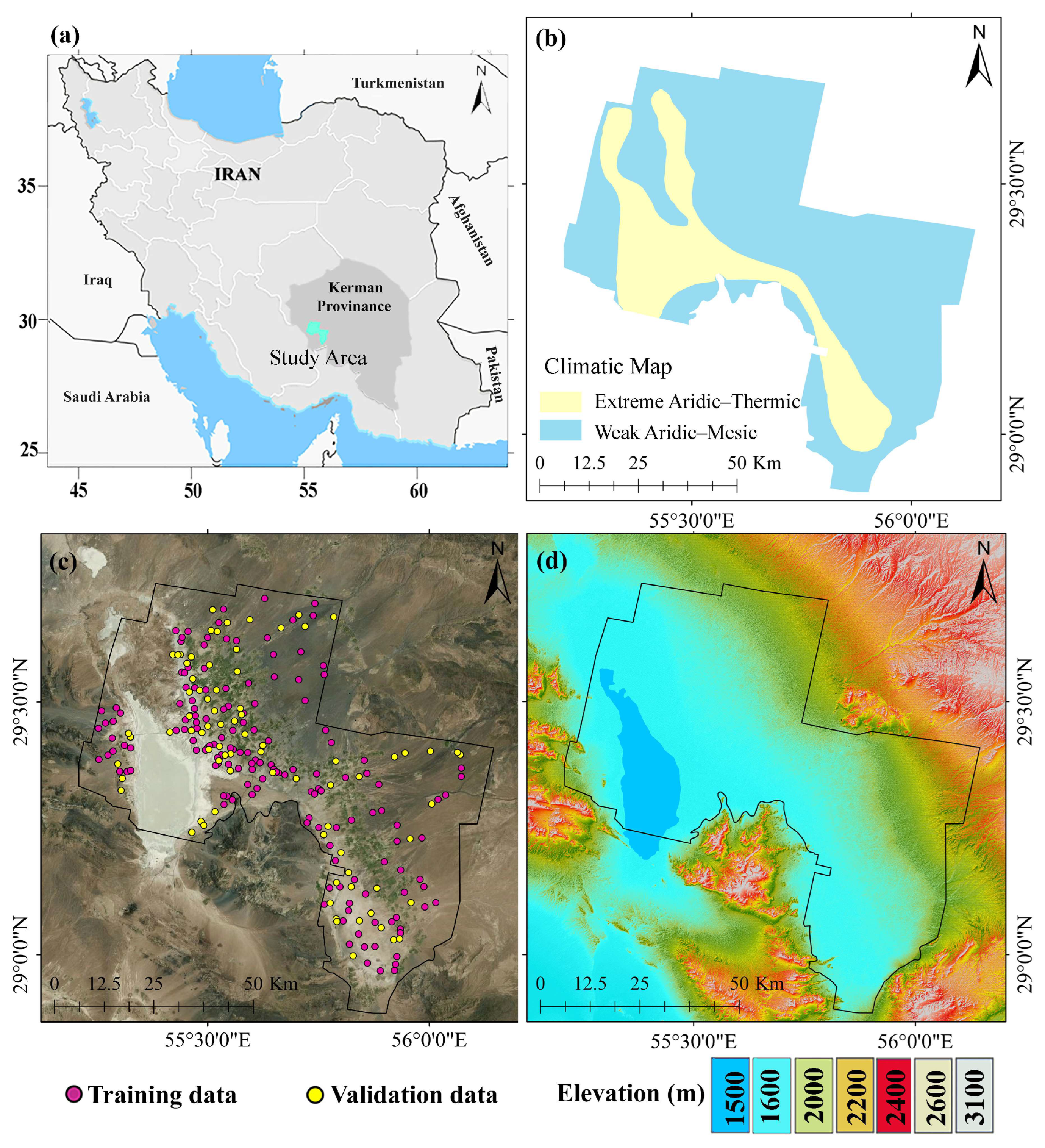


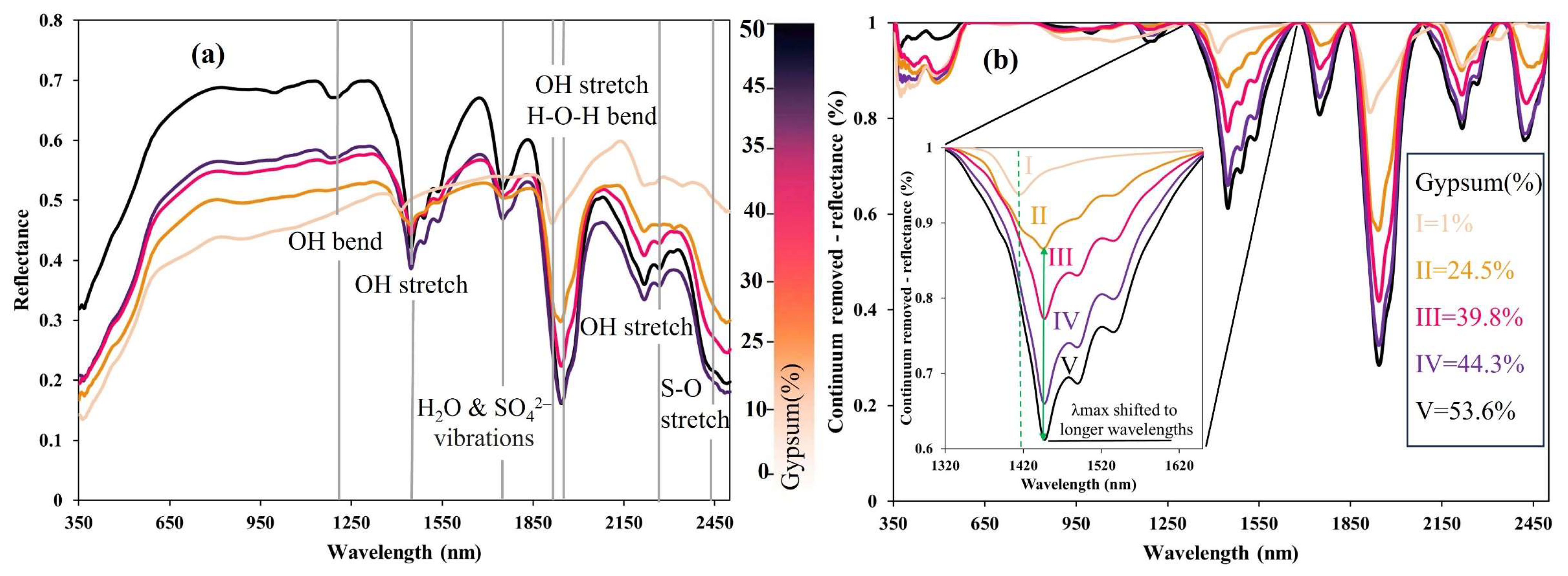
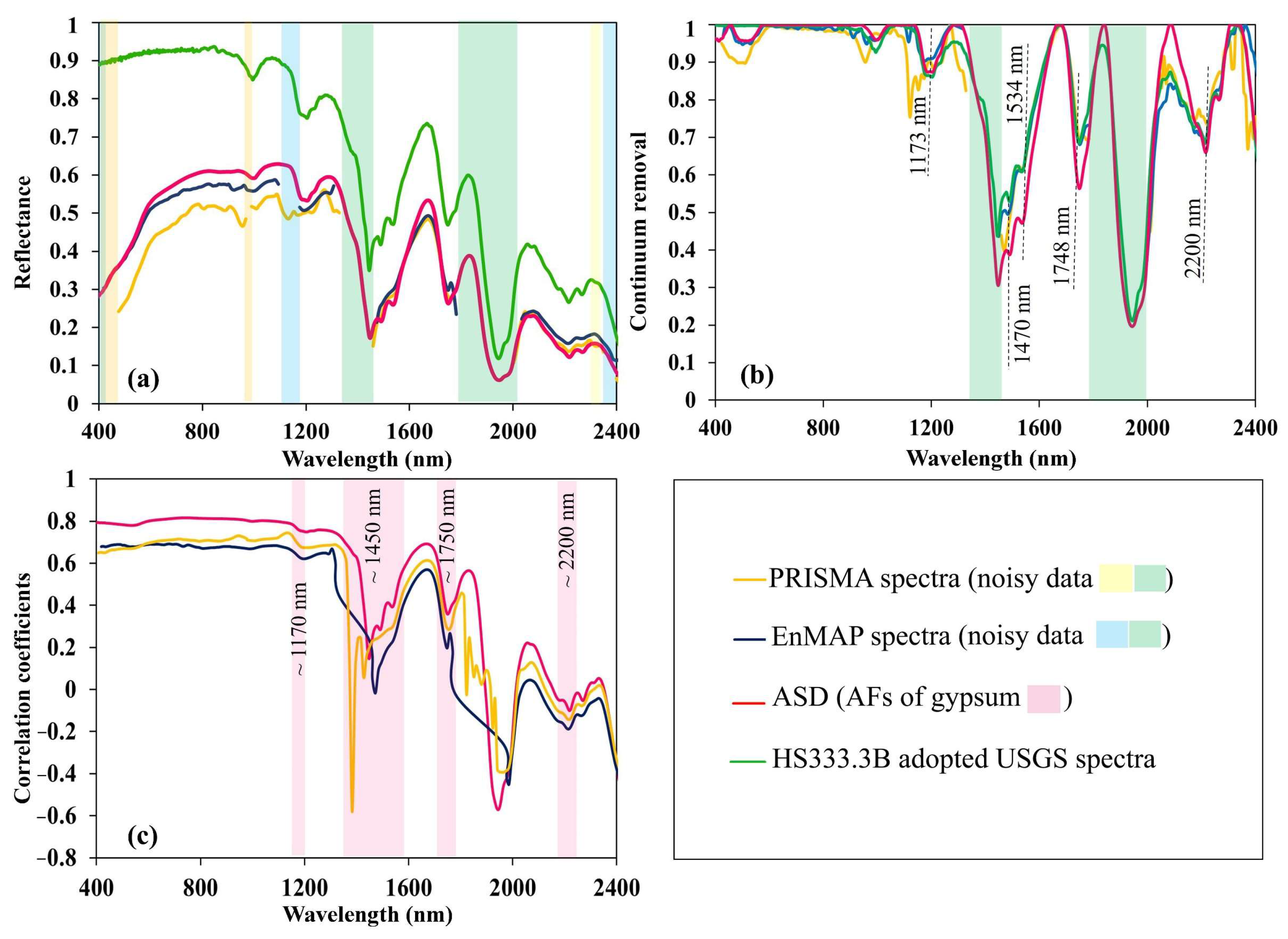
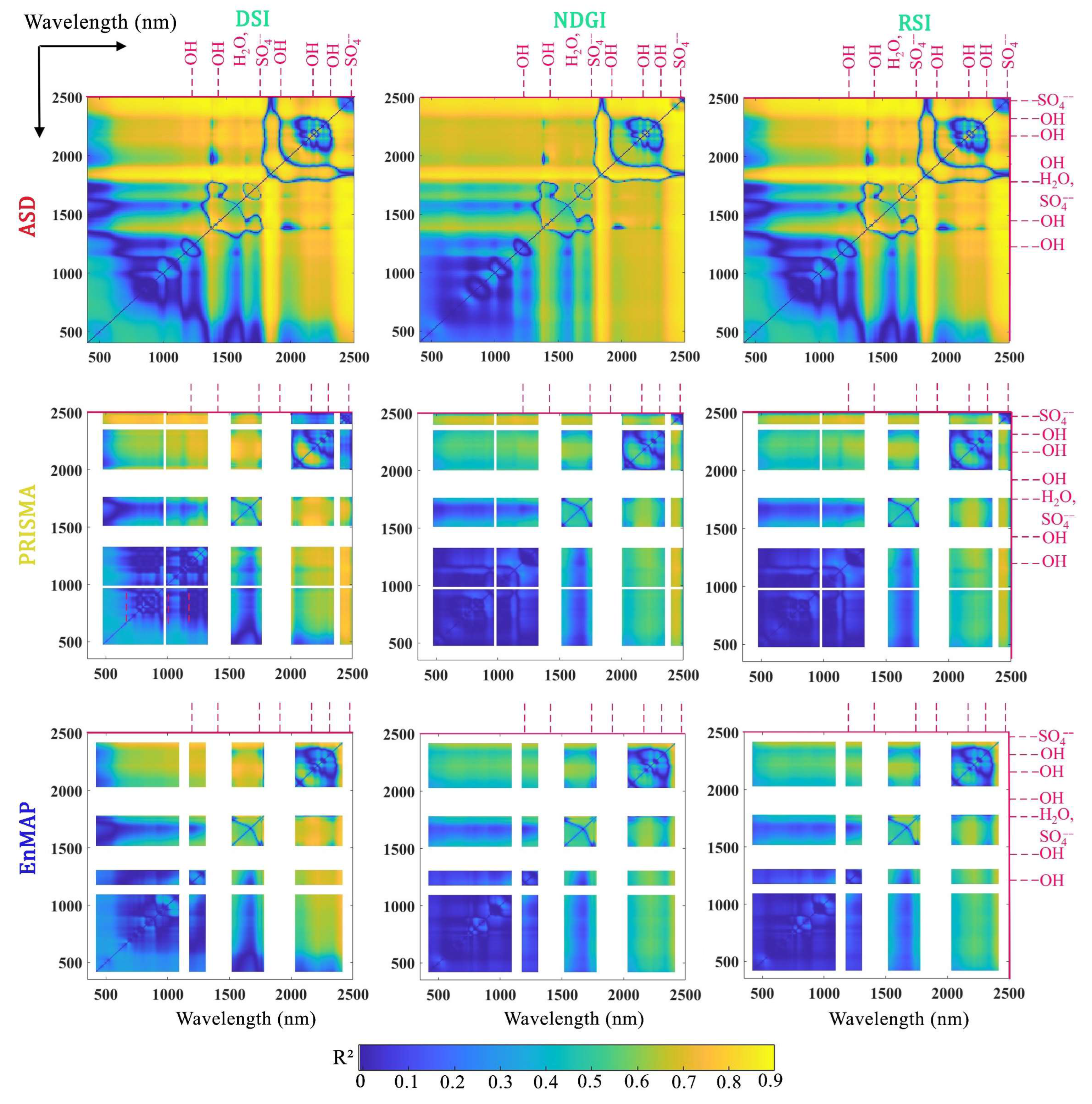
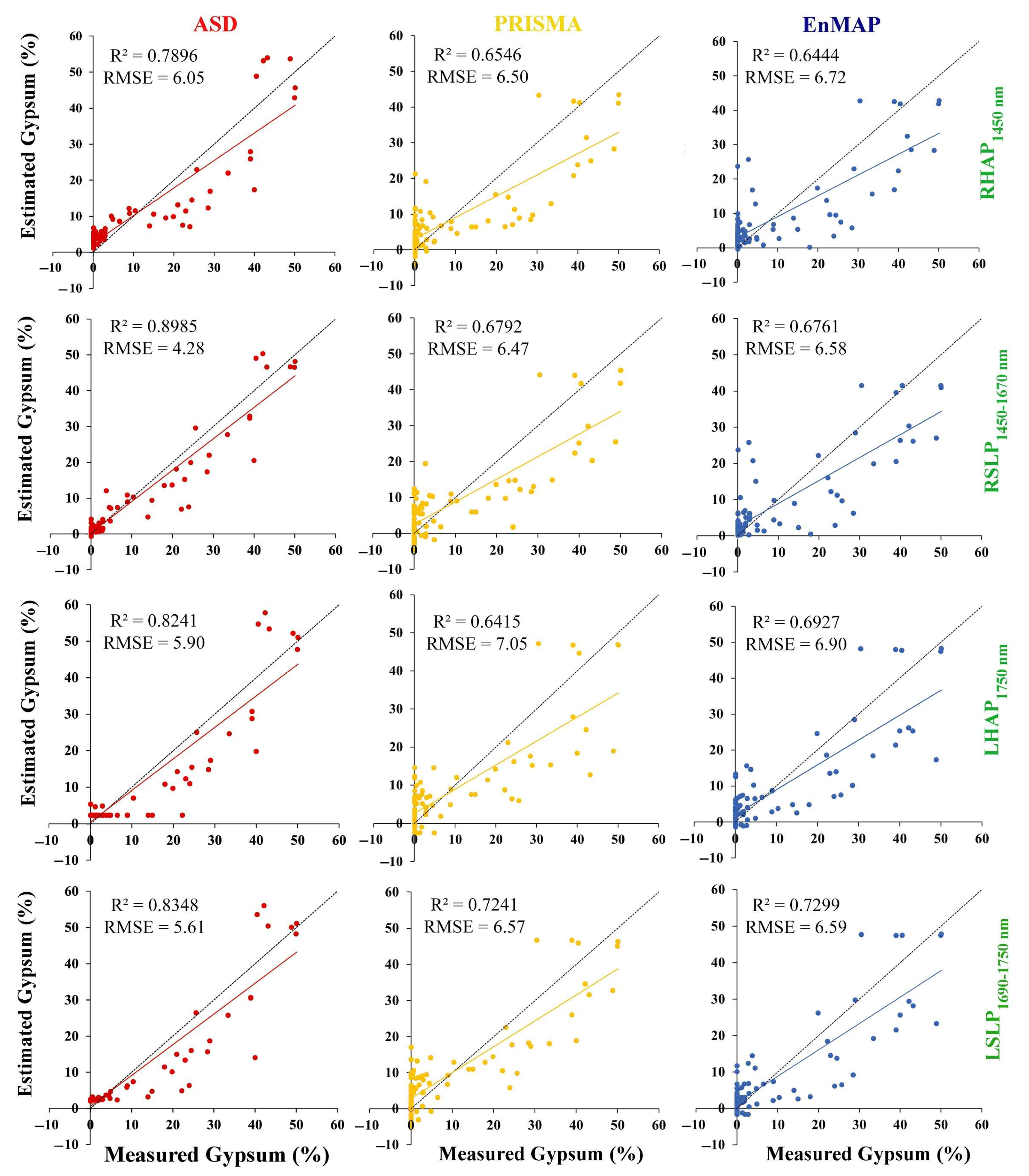
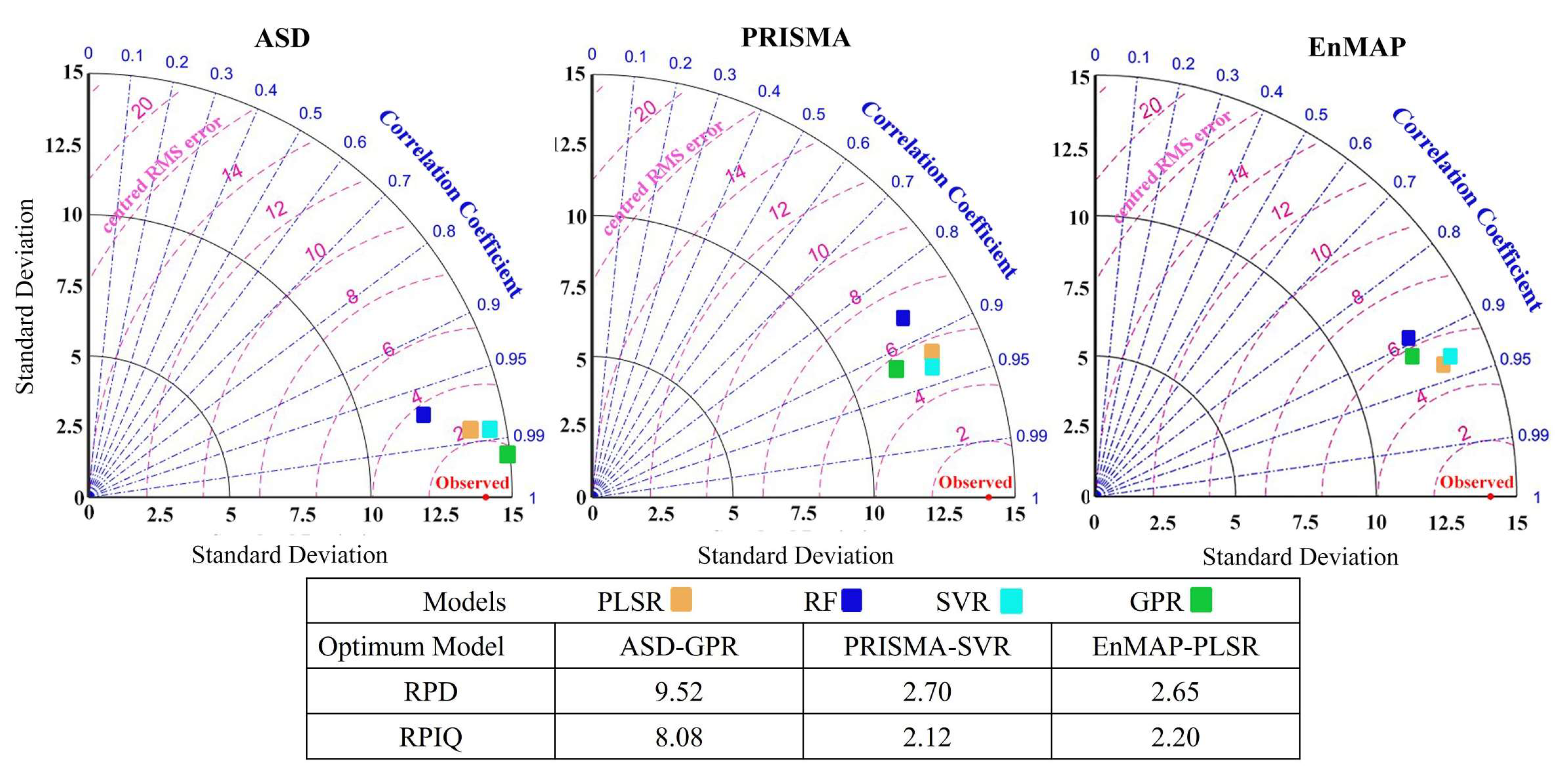
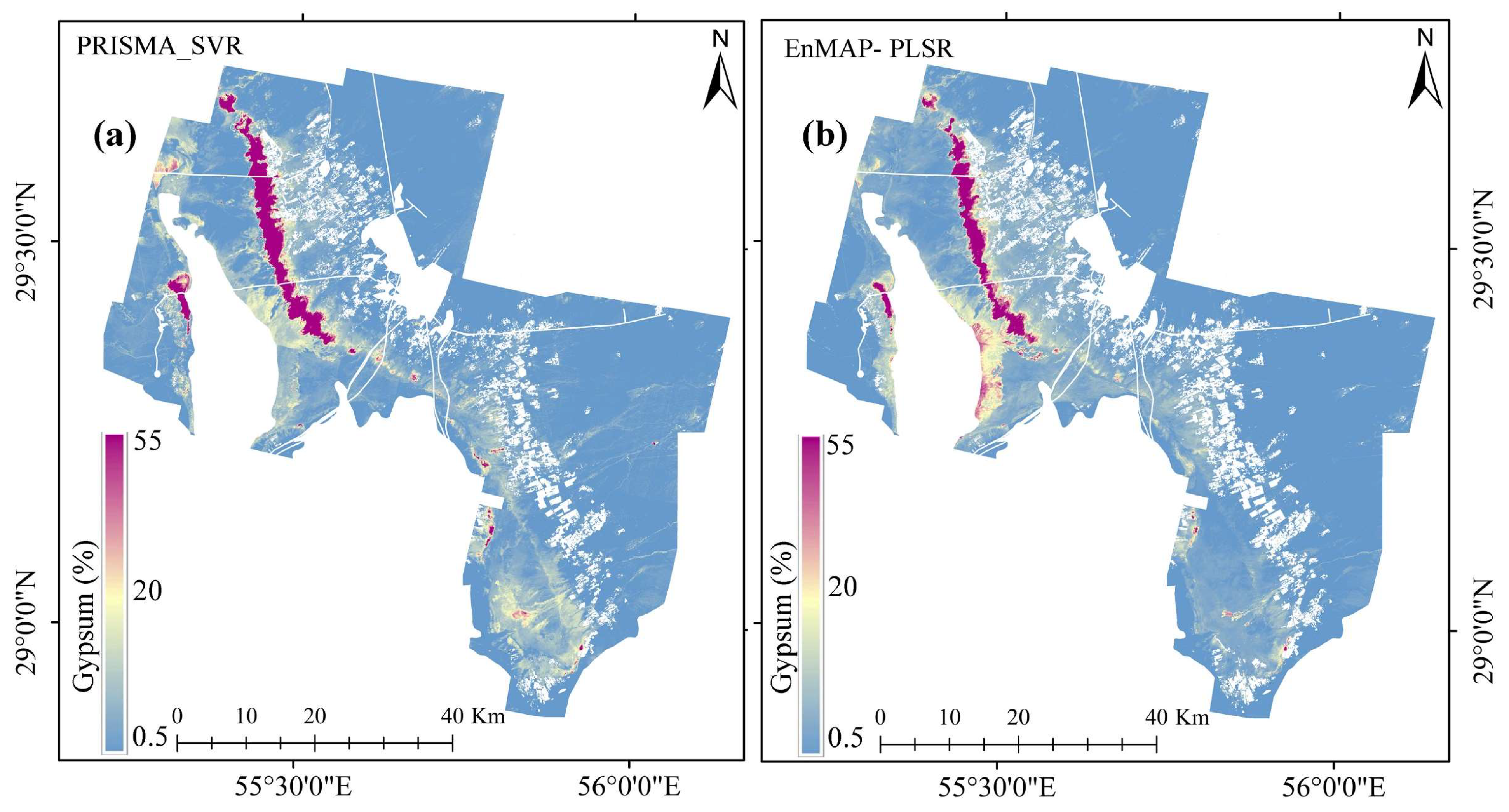
| Sensor | Band | FWHM (nm) | Spatial Res. (m) | SNR | SNR Conditions | Bad Bands (nm) | |
|---|---|---|---|---|---|---|---|
| PRISMA | VNIR 406–978 nm | 63 | ~12 | ~30 | >200:1 in 400–1000 nm >600:1 @ 650 nm | Nadir-looking, 30° sun zenith angle, 0.3 Earth albedo | 406–468, 977–979 |
| 1339–1459, 1793–1993, 2357–2393 | |||||||
| SWIR 943–2497 nm | 171 | >200:1 in 1000–1750 nm >100:1 in 1950–2350 nm >400 @ 1550 nm | |||||
| >200 @ 2100 nm | |||||||
| PAN 400–750 nm | 1 | - | 5 | >240:1 | - | - | |
| EnMAP | VNIR 418–993 nm | 91 | ~6.4 | ~30 | >500 @495 nm | Nadir-looking, 30° sun zenith angle, 0.3 Earth albedo | - |
| SWIR 900–2445 nm | 133 | ~10 | >150 @2200 nm | 1104–1163, 1318–1472, 1967–2023, 2422–2445 |
| PLSR | Parameter | Number of components | |||
| Range | 1–30 | ||||
| Tuned | 20 | ||||
| GPR | Parameter | BasisFunction | KernelScale | KernelFunction | |
| Range | ‘constant’, ‘none’, ‘linear’, ‘pureQuadratic’ | 0.001–1000 | ‘exponential’, ‘matern32’, ‘matern52’, ‘ardsquaredexponential’ | ||
| Tuned | ‘pureQuadratic’ | 16 | “ardsquaredexponential” | ||
| RF | Parameter | NumLearningCycles | Method | MaxNumSplits | MinLeafSize |
| Range | 20–500 | Bag, LSBoost | 1–40 | 1–40 | |
| Tuned | 100 | LSBoost | 10 | 14 | |
| SVR | Parameter | Gamma | C | Kernel type | |
| Range | 0.001–100 | 0.001–100 | Gaussian, Linear, Quadratic, Cubic, RBF | ||
| Tuned | 1 | 10 | RBF | ||
| Variable | N | Min | Max | Mean | Kurtosis | Skewness | Std. | Coef. Var. (%) | KS |
|---|---|---|---|---|---|---|---|---|---|
| Whole dataset | 242 | 0.1 | 55.0 | 8.22 | 1.92 | 1.77 | 14.06 | 171.0 | 0.310 ** |
| Training set | 160 | 0.1 | 55.0 | 7.58 | 2.64 | 1.94 | 13.69 | 180.1 | 0.322 ** |
| Test set | 82 | 0.1 | 50.1 | 9.48 | 1.03 | 1.52 | 14.75 | 155.5 | 0.305 ** |
| Dimensions | Optimal Band Pair | R2 | RMSE (%) | Equation | |
|---|---|---|---|---|---|
| ASD | 2151 | DSI (λ1383, λ2484) | 0.96 | 2.84 | |
| NDGI (λ2400, λ2435) | 0.93 | 3.67 | |||
| RSI (λ2400, λ2435) | 0.94 | 3.31 | |||
| PRISMA | 173 | DSI (λ1534, λ2167) | 0.79 | 6.88 | |
| NDGI (λ2400, λ2435) | 0.73 | 7.77 | |||
| RSI (λ2400, λ2435) | 0.72 | 7.87 | |||
| EnMAP | 182 | DSI (λ1564, λ1769) | 0.84 | 5.90 | |
| NDGI (λ2369, λ2407) | 0.80 | 6.53 | |||
| RSI (λ2369, λ2407) | 0.78 | 6.98 |
| Sensors | ASD | PRISMA | EnMAP | |||||||||
|---|---|---|---|---|---|---|---|---|---|---|---|---|
| Model | R2 | RMSE | RPD | RPIQ | R2 | RMSE | RPD | RPIQ | R2 | RMSE | RPD | RPIQ |
| PLSR | 0.972 | 2.41 | 5.94 | 5.12 | 0.828 | 5.42 | 2.59 | 2.04 | 0.851 | 5.30 | 2.65 | 2.20 |
| RF | 0.941 | 3.18 | 4.42 | 3.42 | 0.755 | 6.70 | 2.11 | 1.62 | 0.792 | 6.08 | 2.31 | 1.80 |
| SVR | 0.971 | 2.51 | 5.73 | 4.91 | 0.835 | 5.20 | 2.70 | 2.12 | 0.844 | 5.55 | 2.56 | 2.00 |
| GPR | 0.989 | 1.52 | 9.52 | 8.08 | 0.829 | 5.27 | 2.64 | 2.10 | 0.825 | 5.59 | 2.52 | 2.10 |
Disclaimer/Publisher’s Note: The statements, opinions and data contained in all publications are solely those of the individual author(s) and contributor(s) and not of MDPI and/or the editor(s). MDPI and/or the editor(s) disclaim responsibility for any injury to people or property resulting from any ideas, methods, instructions or products referred to in the content. |
© 2025 by the authors. Licensee MDPI, Basel, Switzerland. This article is an open access article distributed under the terms and conditions of the Creative Commons Attribution (CC BY) license (https://creativecommons.org/licenses/by/4.0/).
Share and Cite
Rasooli, N.; Mirzaei, S.; Pignatti, S. Monitoring Gypsiferous Soils by Leveraging Advanced Spaceborne Hyperspectral Imagery via Spectral Indices and a Machine Learning Approach. Remote Sens. 2025, 17, 1914. https://doi.org/10.3390/rs17111914
Rasooli N, Mirzaei S, Pignatti S. Monitoring Gypsiferous Soils by Leveraging Advanced Spaceborne Hyperspectral Imagery via Spectral Indices and a Machine Learning Approach. Remote Sensing. 2025; 17(11):1914. https://doi.org/10.3390/rs17111914
Chicago/Turabian StyleRasooli, Najmeh, Saham Mirzaei, and Stefano Pignatti. 2025. "Monitoring Gypsiferous Soils by Leveraging Advanced Spaceborne Hyperspectral Imagery via Spectral Indices and a Machine Learning Approach" Remote Sensing 17, no. 11: 1914. https://doi.org/10.3390/rs17111914
APA StyleRasooli, N., Mirzaei, S., & Pignatti, S. (2025). Monitoring Gypsiferous Soils by Leveraging Advanced Spaceborne Hyperspectral Imagery via Spectral Indices and a Machine Learning Approach. Remote Sensing, 17(11), 1914. https://doi.org/10.3390/rs17111914







